Coinbase
Overall, Coinbase is a secure cryptocurrency platform offering access to digital assets. Coinbase allows traders to view crypto prices and charts and has a trust score of 82 out of 99.
| 🔎 Crypto Platform | 🥇 Coinbase |
| 🎁 Bonuses | ✅Yes |
| ⏰ Support Hours | 24/7 |
| 📌 Fiat Support | ✅Yes |
| 📍 Supported Cryptocurrency Coins | 242 |
| ↪️ Number of Markets | 822 |
| 🚀 Open an Account | 👉 Click Here |
Coinbase Review – Analysis of Providers Main Features
- ☑️ Overview
- ☑️ Detailed Summary
- ☑️ Growth and Development
- ☑️ Services and Features
- ☑️ How to Start Trading on Coinbase
- ☑️ Deposit and Withdrawal Options
- ☑️ Fees, Spreads, and Commissions
- ☑️ Supported Markets and Currencies
- ☑️ Customer Support
- ☑️ Safety and Security
- ☑️ Account Management
- ☑️ Educational Resources
- ☑️ Other Crypto Exchanges vs Coinbase
- ☑️ Conclusion
- ☑️ Frequently Asked Questions
Overview
Coinbase was established in 2012 and is a trusted platform for buying, selling, and storing digital goods. Furthermore, its user-friendly interface is accessible to both novice and seasoned traders.
Coinbase supports millions of verified individuals and hundreds of institutions worldwide, offering various popular cryptocurrencies. In addition, Coinbase is dedicated to protecting users’ security and complying with regulatory regulations.
Beyond trading, Coinbase allows customers to learn about cryptocurrencies, receive incentives, stake their holdings, and interact with the larger crypto community.
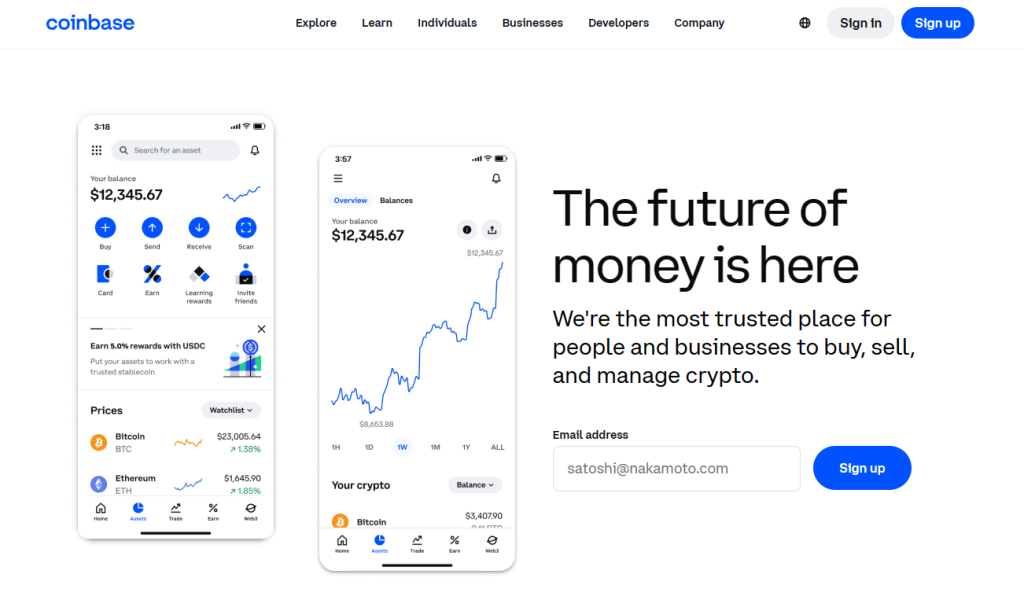
Detailed Summary
| 🔎 Provider | 🥇 Coinbase |
| 📈 Established Year | 2012 |
| 📉 Regulation and Licenses | BitLicense, Money Transmitter, Money Transmission License, BaFin, FINRA |
| 📊 Trust Score | 8.2 |
| 💹 Ease of Use Rating | 5/5 |
| 🎁 Bonuses | New user incentive, sign-up bonus, staking rewards |
| ⏰ Support Hours | 24/7 |
| 📌 Fiat Support | Yes, USD, EUR, GBP, etc. |
| 🪙 Supported Cryptocurrency Coins | 242 |
| 📍 Number of Markets | 822 |
| ↪️ Deposit and Withdrawal Options | Crypto wallets, Fedwire, International Bank Wire, ACH, PayPal, Debit/Credit Card, Instant Cashouts, Apple Pay, Google Pay, Gift Card |
| 🅰️ Maker Fee | From 0.00% - 0.40% |
| 🅱️ Taker Fee | From 0.00% - 0.0045% |
| ⏩ Leverage | 1:10 |
| 💧 Liquidity and Trading Volume | Liquidity is 708 BTC; Trading Volume is 2 billion USD> |
| ▶️ Weekly Visits | 120K+ |
| 🤝 Affiliate Program | ✅Yes |
| ❎ Banned Countries | North Korea, Iran, Syria, and others |
| 🚀 Open an Account | 👉 Click Here |
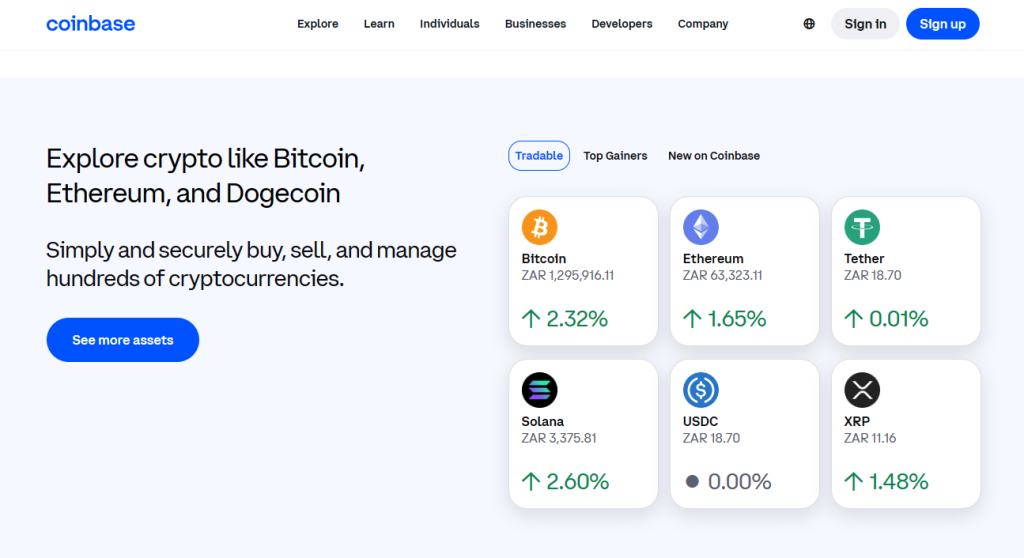
Growth and Development
Coinbase has grown and developed at an amazing rate since it was founded in 2012. An important milestone came in 2013, when the network experienced an increase in both users and trade volume, owing mostly to the growing popularity of Bitcoin.
Over the years, Coinbase has remained committed to developing a safe and user-friendly platform that has attracted a wide user base of individual crypto traders and institutions.
Furthermore, this trend culminated in a historic event in April 2021, when Coinbase became the first major cryptocurrency exchange publicly traded on the Nasdaq stock market.
However, Coinbase’s growth did not stop there. The platform has steadily increased its capabilities, adding more cryptocurrencies for trading, providing features like staking and Coinbase Earn, and venturing into new sectors like its NFT marketplace.
Furthermore, Coinbase has made significant acquisitions of firms like Zabo and Neutrino, improving Coinbase’s capabilities and technical infrastructure.
These achievements reflect Coinbase’s continued attempts to strengthen its position as a cryptocurrency industry leader.
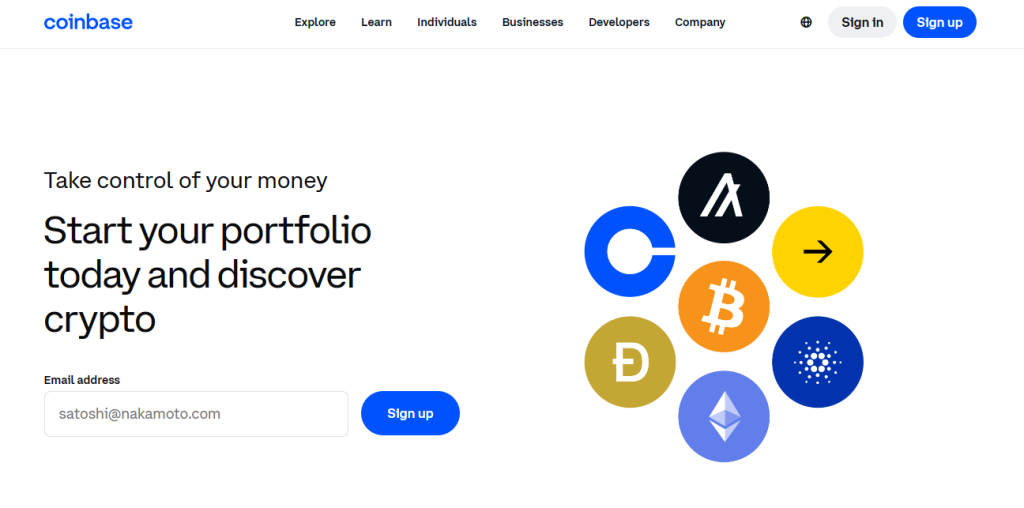
Services and Features
Trading and Exchange
Coinbase provides a user-friendly interface for trading and exchanging cryptocurrencies, making it suited for new and seasoned traders. Users can use the Basic Buy/Sell service to exchange cryptocurrencies for cash or convert between other cryptocurrencies.
For experienced traders, Coinbase Advanced (previously Coinbase Pro) offers a complex platform with reduced costs, several order types, and extensive charting tools for in-depth research.
Furthermore, Coinbase provides Recurring Buys, which allow customers to plan recurring crypto purchases, assisting them in developing a long-term investing strategy and controlling volatility.
Wallet and Custody
Coinbase Wallet provides traders complete control over their private keys, making it ideal for managing digital assets autonomously.
Coinbase also supports a variety of digital valuables for interactions with decentralized apps (dApps) on the Web3.
In addition, Coinbase provides Vault Storage for increased security, combining cold storage options with additional protective layers like withdrawal time delays to keep customers’ assets secure.
Learning and Earning
Coinbase Earn is a program that promotes learning about cryptocurrencies by rewarding traders. Users can earn small quantities of cryptocurrencies when they access and use Coinbase’s comprehensive educational resources.
Coinbase’s Learn and Earn includes short videos explaining digital asset technology. Furthermore, this project not only rewards users but also helps to raise awareness and expertise in the cryptocurrency community.
Additional Services
Card
The Coinbase Card is a Visa debit card that lets US clients spend their crypto holdings on daily purchases.
Furthermore, Coinbase Card pays up to 4% in cryptocurrency rewards and works at all retailers where Visa is accepted, making it ideal for international travelers. The card allows instant payment and easy conversion to fiat. However, there is a 2.49% crypto conversion fee.
In addition, the Coinbase Visa Card is accessible to all US residents except Hawaii and is offered in various European countries, including the UK. While the qualifying criteria are low, traders must be at least 18 to qualify.
Commerce
Coinbase Commerce lets retailers accept cryptocurrency as payment and participate in the crypto economy.
This technology provides a decentralized payment system, providing participating retailers complete control over their assets without needing Coinbase as an intermediary.
Furthermore, Coinbase Commerce fits easily with the Coinbase ecosystem, allowing simple transactions for companies interested in cryptocurrency payments.
NFT Marketplace
Coinbase NFT Marketplace is a new marketplace for buying, selling, and creating non-fungible tokens. This service expands Coinbase’s capabilities, catering to the growing demand for digital art and collectibles.
Furthermore, the marketplace benefits from the popularity of NFTs by providing users with a secure platform for their NFT transactions.
Cloud
Coinbase Cloud provides developer tools and APIs to facilitate the construction of blockchain and crypto-related apps. In addition, it provides infrastructure for diversified blockchain services, including trading, payment processing, and staking.
Coinbase Cloud is part of the Coinbase exchange’s attempts to broaden its offerings to the developer community. It offers a comprehensive resource for individuals who want to innovate in the blockchain sector.
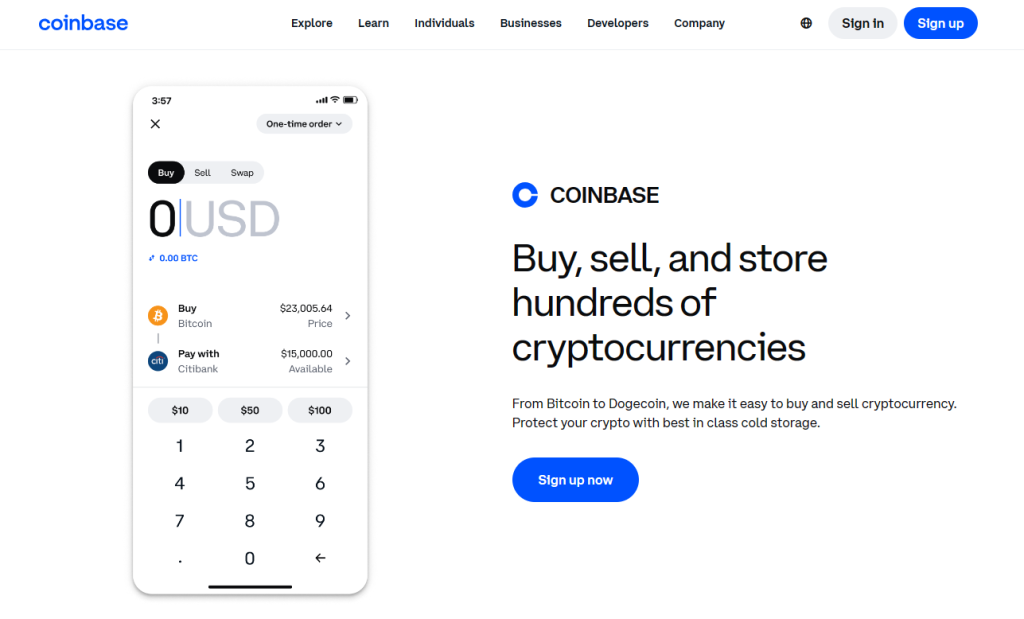
How to Start Trading on Coinbase
To register an account on Coinbase and start trading, follow these steps:
- Sign up for a Coinbase account by going to the website and clicking the “Get Started” button.
- Provide your personal information, including your name, email address, and password.
- Verify your email address by clicking on the verification link that was provided.
- Provide your phone number for two-factor authentication to increase the security of your account.
- Upload a government-issued ID to verify your identity.
- Set up a payment option by connecting your bank account, debit card, or wire transfer.
- To deposit money into your Coinbase account, choose your desired currency in the “Accounts” section.
- Then, click the “Deposit” button and follow the steps.
- Once your account is funded, go to the dashboard and choose the cryptocurrency you want to trade.
- Click the “Buy/Sell” button and the “Buy” tab.
- Then, choose the asset you wish to buy.
- Enter the amount you want to spend or the cryptocurrency you wish to purchase.
- You can even set up recurring purchases at this step if you like.
- Examine the transaction information, including the purchase price and related fees.
- Confirm the transaction if everything is right.
- After the purchase is finalized, your new crypto balance will be shown in your Coinbase account.
You can retain it in your wallet, exchange it for other cryptocurrencies, or withdraw it to a separate wallet.
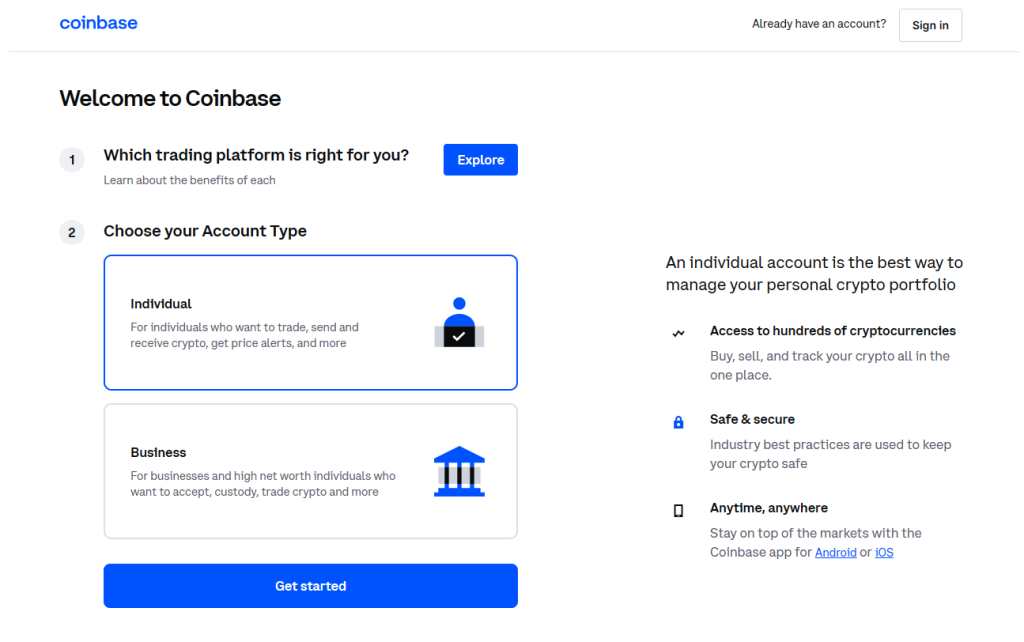
Deposit and Withdrawal Options
Coinbase offers a range of secure deposit and withdrawal options for its customers. Users can connect their bank account to Plaid for direct deposits and easily move money across wallets using crypto deposits.
Furthermore, mobile solutions like Apple Pay and Google Pay make cryptocurrency transactions convenient, while bank wire transfers and debit card withdrawals are available for quick cashouts.
Overall, Coinbase’s top-notch security features ensure flexibility and trustworthiness in asset management.
Here is an overview of how to deposit to Coinbase via the most popular Deposit Options:
Bank Wire
Access the Payment Methods section of your Coinbase account.
- Select ‘Add a payment method,’ then ‘Bank account.’
- Use Plaid to get fast verification by securely logging into your online banking.
- If Plaid is incompatible with your bank or you prefer not to use it, you can manually connect your bank account by clicking ‘Manual link bank account’ and entering your banking information.
Confirm your bank account by entering the two deposit amounts Coinbase initiated into your account.
Credit or Debit Card
Go to the Payment Methods section on your Coinbase account.
- Click the ‘Add a payment method’ banner, then select ‘Debit Card’.
- Enter your card information. You should note that Coinbase will make two minor debits from the card.
Validate the card by typing the displayed amounts into the Coinbase interface (Note: While Coinbase no longer allows the connecting of new credit cards, previously connected ones are still valid).
Cryptocurrency
Login to your Coinbase account.
- Navigate to the Assets tab and choose the cryptocurrency you want to deposit.
- Select the “Receive” option.
Use the specified wallet address to send cryptocurrency from your external wallet to Coinbase.
e-Wallets or Payment Gateways
Go to Coinbase’s “Settings,” then “Payment Methods.”
- Select PayPal or any other supported e-wallet.
You will be redirected to log into the e-wallet account and verify the transaction.
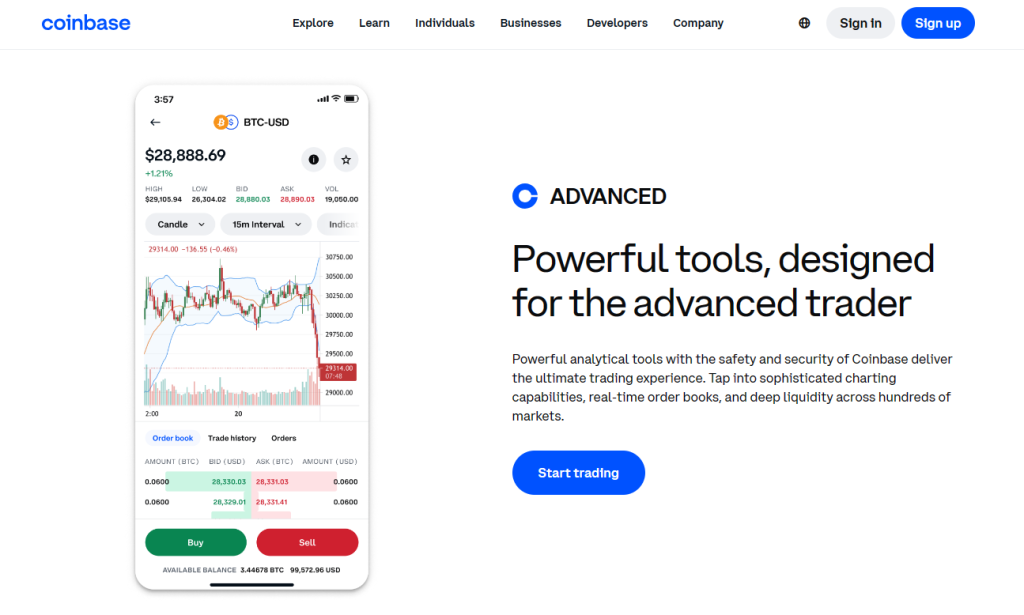
Here is an overview of how to make a Withdrawal from Coinbase via the most popular Withdrawal Options:
Bank Wire
Access your USD balance in Assets.
- Choose ‘Cash out’, then ‘Wire transfer’ as the withdrawal method.
- Confirm your banking information and continue with the cashout.
Typically, funds are reflected in your account within a few business days.
Credit or Debit Cards
Select the asset to pay out and select the amount.
- Choose the option to ‘Cash out’.
- Select your debit card for withdrawal.
Confirm transaction information and complete the cashout.
Cryptocurrency
Find the “Receive” feature in your external cryptocurrency wallet and copy the address for the coin you wish to receive.
- In Coinbase, go to the “Assets” section and choose the coin to withdraw.
- Click “Send,” enter your wallet’s receiving address, and set the withdrawal amount.
Review and confirm the transaction.
e-Wallets or Payment Gateways
In Coinbase, click “Cash out” and choose your preferred e-wallet. Enter the amount and follow the directions.
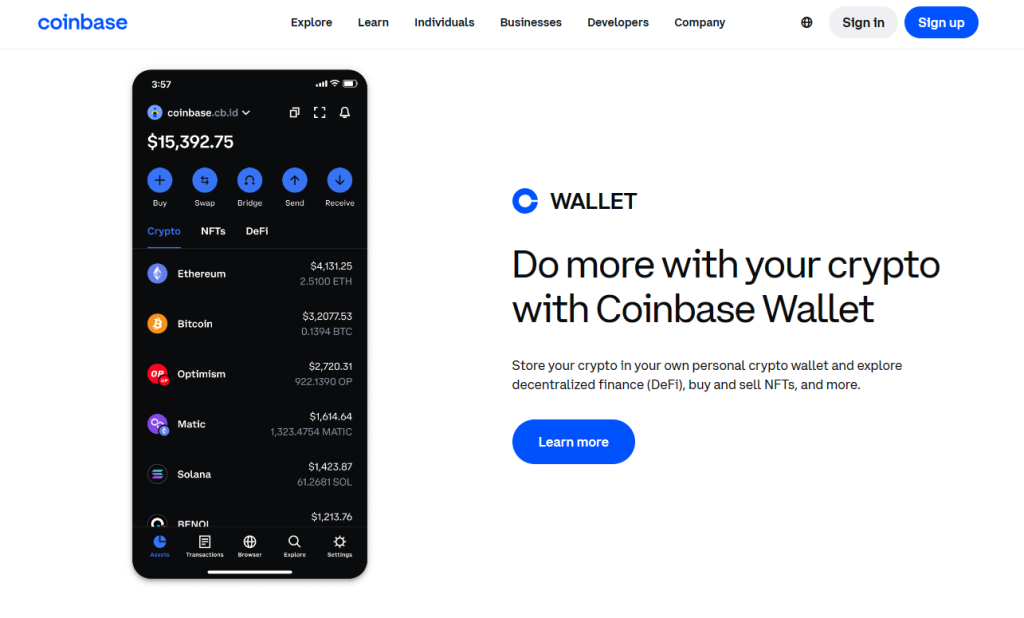
Fees, Spreads, and Commissions
Maker and Taker Fees
Coinbase uses a maker-taker fee structure to promote trading activity and maintain market liquidity. User fees are determined by trading volume over 30 days, with larger volumes resulting in reduced fees.
Furthermore, quick order execution charges range from 0.05% to 0.60%, while non-quick order matching charges range from 0% to 0.40%.
Primary Balance
Coinbase customers enjoy free transfers between accounts without charges for storing funds or cryptocurrencies in their main balance. However, when sending cryptocurrency outside the platform, customers can incur network transaction costs, often paid to miners.
Trading Fees and Spread
Coinbase charges fees for trading, which are fixed and variable based on payment method and order amount. Coinbase also charges a spread, a minor pricing differential, to maintain stability during order processing.
Asset Recovery
Coinbase provides asset recovery services for cryptocurrencies accidentally transferred to a Coinbase account, with network costs and an additional 5% fee for recoveries exceeding $100, and market movements can affect the final recovery values.
Coinbase Card
With the Coinbase Card, traders can use cryptocurrencies or USD for transactions, earning up to 4% in cryptocurrency rewards without incurring transaction fees. However, users must pay a 2.49% conversion fee for direct cryptocurrency use.
Staking Services
Coinbase offers staking services for proof-of-stake coins, letting users receive returns on their staked assets. Despite no cost for staking or unstaking assets, Coinbase will deduct a commission on staking rewards, typically 35%, with lower rates available for eligible traders.
Fiat Deposit and Withdrawal Fees
Coinbase offers various deposit and withdrawal methods for fiat funds, each with its fee structure as follows:
- US customers can use ACH transactions for free, while wire transfers cost $10 for deposits and $25 for withdrawals.
- European customers can use SEPA transfers for €0.15 and free for deposits and withdrawals, while UK customers can make free Swift deposits and pay a minimal £1 charge.
Miner Fees
Coinbase calculates miner fees for blockchain transactions to ensure timely confirmation. Although estimates are provided, the final value will vary because of blockchain conditions.
However, these fees are communicated to traders, allowing them to understand cryptocurrency transfer costs, especially during network congestion.
USDC to USD Conversion Fees
Coinbase has a tiered fee system for significant net conversions between USDC and USD, with transactions up to $75 million being fee-free and those beyond this subject to costs ranging from 0.10% to 0.20%. This system aims to minimize the market effect of large-scale conversions.
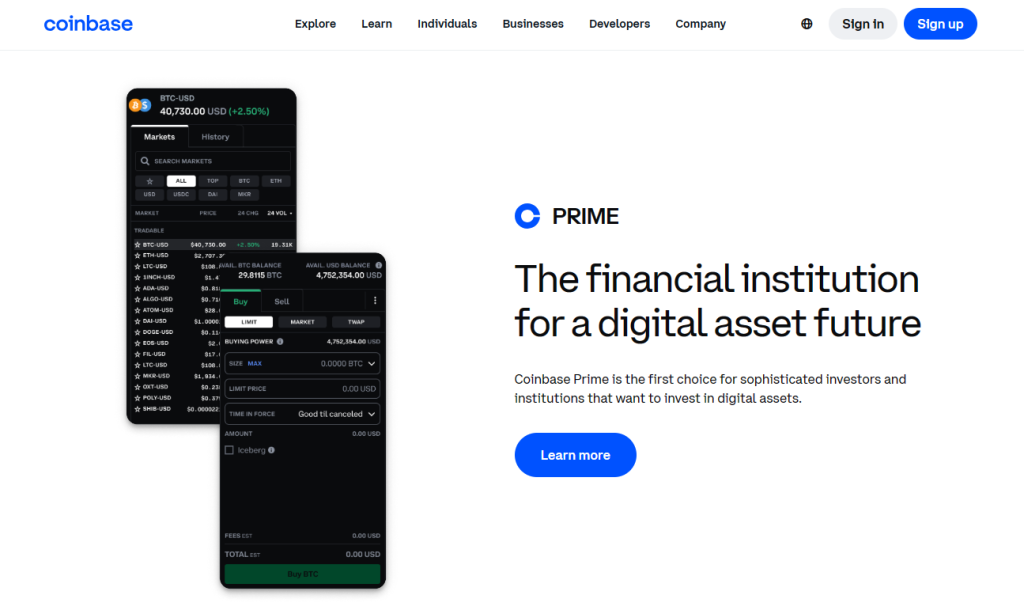
Supported Markets and Currencies
Fiat Currency Support
- USD: Coinbase provides multiple USD-related services, including USD wallets and USD trading pairs for various cryptocurrencies.
- EUR: For European users, EUR is generally accepted for transactions and trading, with the added convenience of SEPA transfers for deposits and withdrawals.
- GBP: UK users can trade cryptocurrencies in GBP and use Swift transfers for transactions.
Cryptocurrency Support
Coinbase is noted for providing a wide selection of cryptocurrencies for trade, including but not limited to the following:
- BTC: BTC is the earliest and most well-known cryptocurrency and is a fixture of the Coinbase platform, with various trading pairings accessible.
- ETH is the second-largest cryptocurrency by market capitalization and is critical to the Coinbase ecosystem, particularly its smart contract features.
- Litecoin (LTC) and Bitcoin Cash (BCH) are among the notable cryptocurrencies accessible on Coinbase as alternatives to Bitcoin.
- Stablecoin (USDC): USDC is a stablecoin tied to the USD, providing price consistency for those wishing to reduce volatility.
- ERC-20 tokens: Coinbase supports several ERC-20 tokens based on the Ethereum blockchain, catering to various use cases and projects.
Trading Pairs
Coinbase offers a wide range of trading pairs for supported cryptocurrencies, including, but not limited to, the following:
- Crypto to Crypto Pairs: Coinbase also offers trading between other cryptocurrencies, such as ETH/BTC, which provides a means to diversify crypto holdings.
- Fiat-to-crypto Pairs: Users can exchange cryptocurrencies with fiat currencies such as BTC/USD, ETH/EUR, and LTC/GBP, among others.
- Stable Pair Trading: Trading pairings using stablecoins, such as USDC, are also available and are often used to hedge against market volatility.

Customer Support
Various customer care methods are on offer, including:
- The Help Center has enhanced its customer service by offering comprehensive self-help articles and troubleshooting tips.
- Email Support lets users submit tickets for comprehensive queries for personalized support.
- Social Media offers quick support to traders and community support forums for member assistance.
- Live Phone Support assists with account security issues, but its service is limited to specific risks and not as comprehensive as other options.
- The 24/7 Live chat and ticketing system emphasizes its commitment to real-time support and user-friendliness for beginners.
Despite several enhancements, some customers have reported poor response times and difficulty addressing complicated problems.

Safety and Security
Coinbase prioritizes security measures, acknowledging its responsibility as a custodian of significant client funds. Among its key security procedures are the following:
- The platform uses “cold storage” for most trader cryptocurrency holdings. By holding these assets on offline hardware devices, Coinbase reduces the risk of hacking attempts, which are frequent on internet platforms, thus improving user security.
- This provider requires strong 2FA solutions, with a preference for security keys or authenticator applications. This extra layer of authentication considerably improves the security of user accounts, limiting the possibility of unwanted access even in the case of leaked passwords.
- Thorough criminal insurance coverage offers an extra layer of security. This insurance covers a percentage of digital assets in the event of theft or cybersecurity breaches, giving traders an extra layer of protection and comfort about the security of their holdings.
- Furthermore, Coinbase follows stringent regulatory guidelines.
Finally, Coinbase is audited frequently to verify that it meets all legal standards and industry rules.

Account Management
Setting Up and Verifying Your Account
Coinbase accounts require basic personal information like name, email, and password for first-time users. To validate, users must provide a picture ID and relevant information, which is crucial for unlocking all account capabilities, including trading and transactions.
Account Security
Coinbase prioritizes account security with various tools and advice, including two-factor authentication (2FA), strong, unique passwords, and regular account activity reviews. Furthermore, Coinbase also accepts hardware security keys for added security.
Trading Platform
Coinbase offers a user-friendly trading platform suitable for beginners and experienced traders. It offers two options: Coinbase Basic for basic trading and Coinbase Advanced for sophisticated trading.
The basic platform offers a straightforward interface for buying, trading, and exchanging coins, while Coinbase Advanced offers extensive charts, order books, and advanced order types.
Portfolio Management
Coinbase provides a platform for managing portfolios effectively, allowing users to track assets, view transaction history, and analyze performance over time. The dashboard offers a clear view of current balances and recent activities, while Coinbase Pro offers additional analytics and reporting options.
Mobile App
The Coinbase mobile app provides the same convenience and functionality as the online platform, enabling users to manage their accounts, trade, and remain secure while traveling.
Furthermore, the Coinbase app is user-friendly, allowing you to easily monitor your portfolio, perform trades, and control account security from your mobile device.
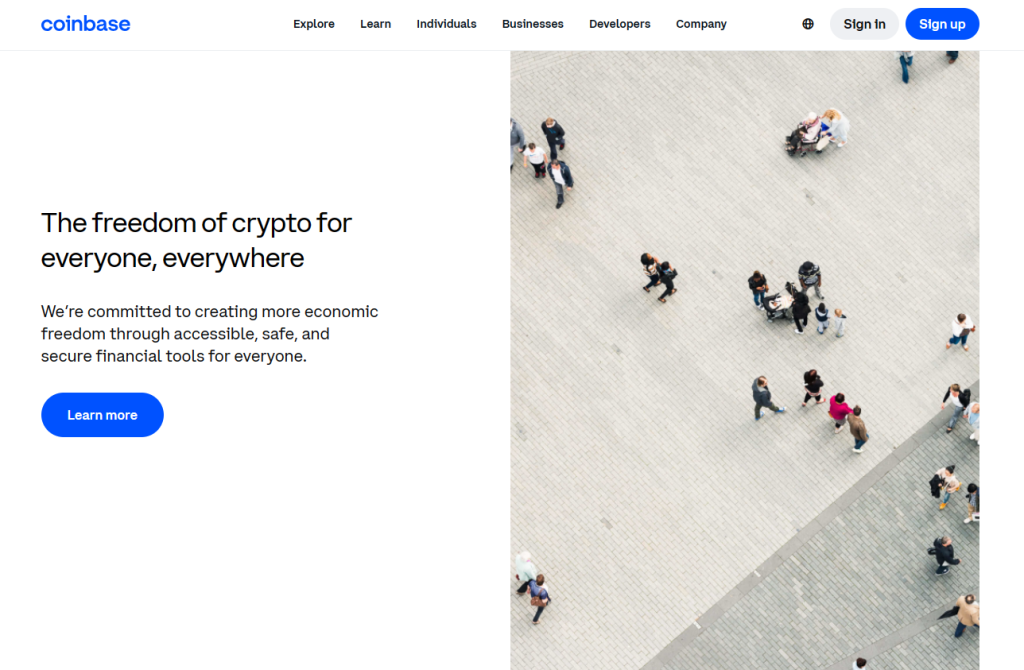
Educational Resources
The following resources and educational materials are on offer:
- Coinbase Learn is a comprehensive website that addresses cryptocurrency-related questions, offering guides and explanations on various topics catering to beginners and advanced crypto enthusiasts.
- The Help Center provides comprehensive guidance on account administration, trading, and security, appealing to traders and companies due to its organized structure.
- Coinbase Resources offers a comprehensive collection of critical materials on crypto principles, investing methods, and finance, including Satoshi Nakamoto’s Bitcoin whitepaper and instructional films.
The Coinbase Blog provides a comprehensive overview of Coinbase’s operations, market updates, and cryptocurrency world views, featuring thought leadership articles from Coinbase executives and guest authors.
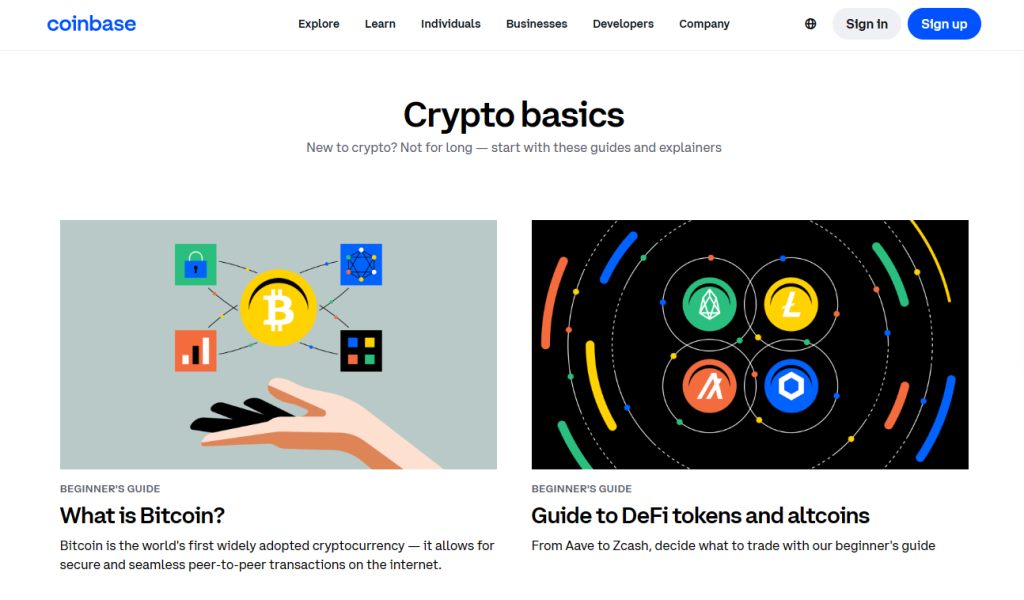
Other Crypto Exchanges vs Coinbase
Gate.io vs Coinbase
Gate.io offers diverse cryptocurrencies and comprehensive trading capabilities, making it suitable for experienced traders.
Unlike Coinbase, Gate.io focuses on the altcoin market, providing access to developing coins and trading pairings.
However, Gate.io’s user interface might be overwhelming for beginners, and its worldwide reach and less strict verification methods could require customers to balance accessibility and security.

KuCoin vs Coinbase
KuCoin is a popular cryptocurrency platform known for its diverse offerings and affordable trading costs. KuCoin’s user-friendly interface caters to a global audience and offers features like futures trading and staking.
Unlike Coinbase, which prioritizes regulatory compliance and protected USD deposits, KuCoin prioritizes anonymity and minimal costs, making it more appealing to advanced users.

Bybit vs Coinbase
Bybit is a derivatives trading platform specializing in perpetual contracts for cryptocurrency, catering to traders seeking leverage options and sophisticated trading tools.
Furthermore, Bybit’s interface is straightforward but requires a solid understanding of derivatives trading.
Coinbase focuses on spot trading and offers beginners a safer, regulated environment, while Bybit offers higher potential rewards via leverage but carries more risks.
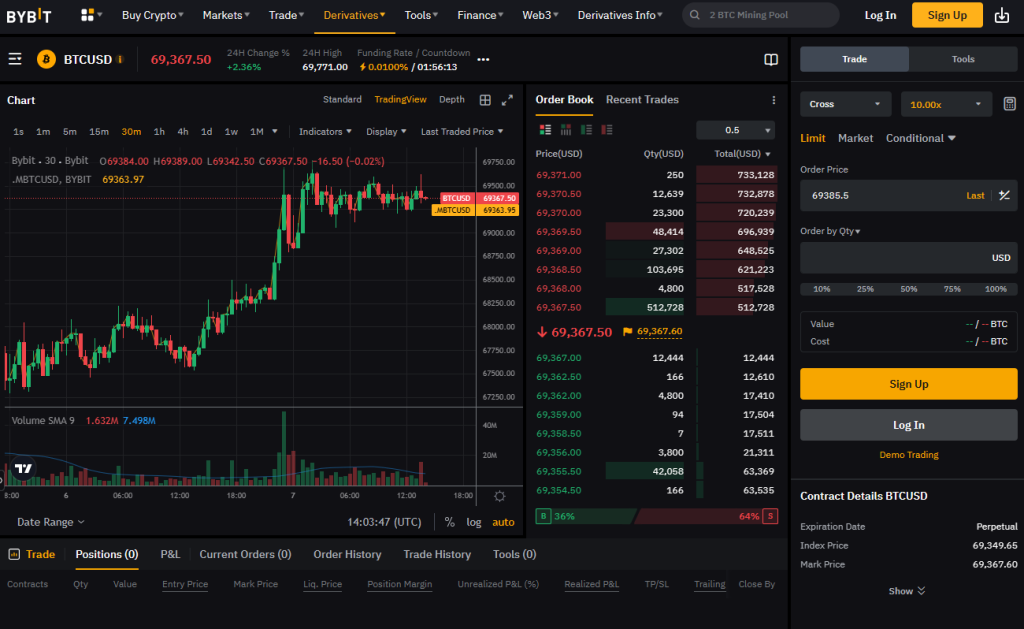
Conclusion
Our findings show Coinbase is a dependable and user-friendly platform ideal for novice and experienced cryptocurrency traders. Furthermore, Coinbase provides a broad range of services, including support for multiple cryptocurrencies, fiat currencies, and trading pairs to accommodate a variety of trading preferences.
Per our research, Coinbase prioritizes security, with strong mechanisms to protect customer funds, regulatory compliance, and insurance coverage. Furthermore, to improve the trading experience, Coinbase often includes new features such as staking, an NFT marketplace, and training materials.
| Broker | Review | Regulators | Min Deposit | Website | |
|---|---|---|---|---|---|
| 🥇 |  | Read Review | ASIC, FSA, CBI, BVI, FSCA, FRSA, CySEC, ISA, JFSA | USD 100 | Visit Broker |
| 🥈 |  | Read Review | FSCA, IFSC, ASIC, CySEC, DFSA, FCA | USD 5 | Visit Broker |
| 🥉 |  | Read Review | FCA, FSCA, FSC, CMA | USD 200 | Visit Broker |
| 4 |  | Read Review | ASIC, BaFin, CMA, CySEC, DFSA, FCA, SCB | USD 200 | Visit Broker |
| 5 |  | Read Review | FSC, FSA, VFSC | USD 10 | Visit Broker |
| 6 |  | Read Review | CySEC, MISA, FSCA | USD 25 | Visit Broker |
| 7 |  | Read Review | CySEC, FCA, FSA, FSCA, Labuan FSA | USD 100 | Visit Broker |
| 8 |  | Read Review | CBCS, CySEC, FCA, FSA, FSC, FSCA, CMA | USD 10 | Visit Broker |
| 9 |  | Read Review | ASIC, CySEC, FSCA, CMA | USD 100 | Visit Broker |
| 10 |  | Read Review | IFSC, FSCA, ASIC, CySEC | USD 1 | Visit Broker |
Frequently Asked Questions
What is Coinbase, and how does it work?
Coinbase is a major cryptocurrency exchange and wallet platform. It has an easy-to-use interface for buying, selling, storing, and exchanging multiple cryptocurrencies.
How long does Coinbase’s withdrawal take?
Withdrawals depend on the trader’s region, and the withdrawal method used. SEPA transfers can take up to two days, while US payment methods can take up to 5.
Coinbase also supports withdrawals through mobile solutions like Apple and Google Pay, e-wallets, and crypto, which could be instant or take a few hours.
How can I open a Coinbase account?
Visit the Coinbase website or download the mobile app. Complete the application by providing personal information, authenticate your identity (KYC), and choose a payment method to fund your account.
What is Coinbase’s minimum deposit?
Coinbase does not have a set minimum deposit. The minimum that can be deposited will depend on the region and traders’ payment method.
Is Coinbase a safe crypto exchange?
Yes, Coinbase is a well-regulated safe exchange that offers several security measures like cold storage, 2FA, regular audits, and more.
Does Coinbase file IRS reports?
Yes, Coinbase can disclose some taxable activities to the IRS or appropriate tax authorities, depending on your location and activity volume.
Which cryptocurrencies can I trade with Coinbase?
More than 242 cryptocurrencies, including Bitcoin, Litecoin, DeFi tokens, and more, can be traded.
Where is Coinbase based?
Coinbase is headquartered in San Francisco, California, in the United States.
Can novices use Coinbase?
Yes! Coinbase’s emphasis on simplicity makes it one of the more user-friendly alternatives for newcomers to the cryptocurrency space. However, the fee structure can be confusing for beginners without prior experience with crypto exchanges.

